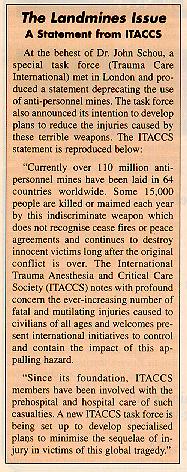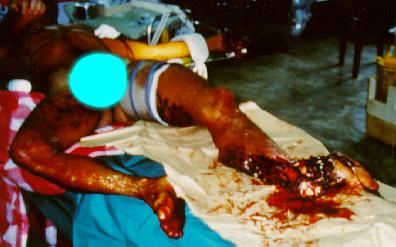do not
forget - don't
forget them either!
Mine ConstructorsNon-Signing States
Cluster-Bombs
After
considerable efforts for generating an international ban of the
anti-personal mines [AP, "landmines"], culminating in the "Mine Ban Treaty" of 1997 and the Nobel prize for the International
Campaign to Band the Landmines and its president, Judy Williams,. a
certain
saturation in the public attention of this problem can be felt.
Thereby, AP
remains the very dominating problem in those regions which are infested
with
them. Only small parts have actually been cleaned and the biggest
nations and
mine-producers (
 Fig. 1: ITACCS-resolution upon
AP (TraumaCare 1996;6,2:8.)
Fig. 1: ITACCS-resolution upon
AP (TraumaCare 1996;6,2:8.)
An
essential description of the challenge of AP to civilians is given in
the resolution, forwarded by Dr. Peter Baskett, then president of the
International Trauma Anaesthesia & Critical Care Society [ITACCS]
at
its meeting in
<ul=type
circle specific disease, specific abnormal physiological state,
specific
abnormal psychological state, specific and permanent diasbility or
specific
disfigurement; field mortality of more than 25% or hospital mortality
of more
than 5%; grade 3 wounds as measured by the Red Cross wound
classification; or
effects for which there is no well recognized and proven treatment.
From:
Coupland RM and the SIrUS Project Group. Towards a determination of
which
weapons cause "superfluous injury or unneccessary suffering".
Publication of the ICRC, Genéve 1997, 44 pp.
The SIrUS
project has been endorsed by many societies, including the Association
of
Anaesthetists of Great Britain and
 Fig. 2: Young Cambodian man
with amputation injury of the left foot. Healed amputation of the right
leg
bears wittness that this was not his first meeting with a landmine
(Photo: Dr.
Hans Boie,
Fig. 2: Young Cambodian man
with amputation injury of the left foot. Healed amputation of the right
leg
bears wittness that this was not his first meeting with a landmine
(Photo: Dr.
Hans Boie,
So,
the mines are mostly still there where they were when a more intense
public opinion could be traced. Even if it should prove possible to
block
further distribution, a large-scale removal needs to be carried out. To
a
considerable part, this is a possible task-but where is the will (and
the
money) to do so? Mercantile aspects are used to block competers from
getting a
prosperous "cleasning task," although this does not guarantee
bringing anybody else into business. As a result, it would be good if
you -
personally - would consider what you could do against the evolving
apathy.
Perhaps in spreading the message to other individuals, perhaps by
influencing
some organization or society in which you are a member.

Fig. 3: Cambodian boy with
serious amputation injury of the left foot (Photo: Dr. Hans Boie,
Are
Cluster-Bombs also Landmines?
In
the American-English-Iraqi War 1993, a
large number of socalled “cluster-bombs” were utilized by the
allied forces.
These shells explode with a distribution of fragments over as much as
2,400 m2,
and they can hardly be regarded a military weapon, as most of its
victims are
civilians. Moreover, the cluster-bombs have a high failure rate of up
to 50%
and they are easily confused with the packets for emergency food supply
(of the
same colour). Thus, unexploded munition waits for civilian victims
(predominantly children) to enter their trap.
Moreover, other malicies are
threatening Iraqui civilians. Since
the first Iraqui war in 1991, a
large number of uranium-enriched
shells
were utilized for the purpose of increasing their penetration. Similar
shells
were distributed over
Towards the end of
their lawless aggression towards Lebanon in July-August 2006, the
Israeli army distributed ~2 million clusterbomblets in South Lebanon,
the majority within the last two days as was already clear that there
should be an armistice. It is estimated that 40% did not instantly
explode. The IDF also admitted to
having used chemical warfare with white phosphour (as used by the
Americans in Falludja 2004) but claimed that also this was no war
crime. What is it, then?
A study, which was financed by the Norwegian government in 2006 - the first to document the impact of cluster munitions on people in all 24 countries and regions known to be affected by these weapons - showed that 98% of cluster bomb victims are civilians. The International Red Cross started a campaign for prohibiting the cluster-bombs, an initiative 18 civilized countries immediately supported (but unfortunately not the warrier nations).
Links:
Handicap
International (Germany)
Read
more about how to support victims of landmines in Save Lifes, Save Limbs
Ban Cluster Bombs
Updated May 23, 2009
